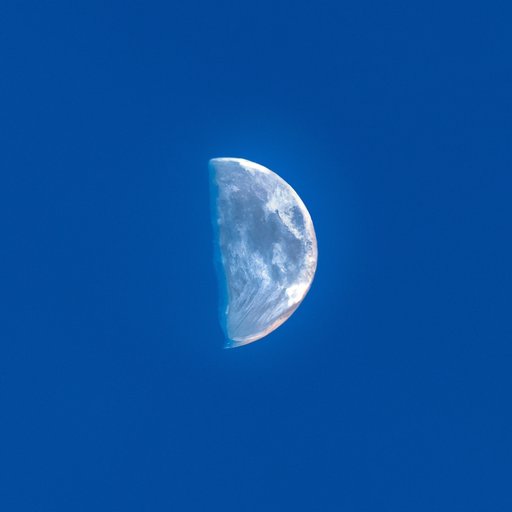
Introduction
Have you ever looked up at the sky on a sunny day and been caught off-guard by the sight of the moon? Many people are surprised to learn that they can actually see the moon during the day, and they often wonder about why that is. In this article, we will delve into the mystery of daytime moon viewing and explore the science behind it. By the end, you’ll be equipped with the knowledge to embrace this phenomenon and maximize your moon-gazing experiences.
The Mystery of the Daytime Moon: Explained
One common misconception is that the moon disappears during the day. This is not true – the moon is present in the sky for the entirety of each day, although it may be harder to see depending on a number of factors. The moon’s visibility during the day depends primarily on two things: its relative brightness versus the sun, and its location in the sky.
Despite being less bright than the sun, the moon is still visible during the day because our eyes are sensitive enough to pick up its faint light. When the sun is at its highest point in the sky, the moon may appear washed out or pale in comparison, which is why it can be easiest to spot it when it is near the horizon. The moon’s location in the sky also plays a significant role in its visibility and can determine how much of it is visible.
Glimpsing the Moon: A Daytime Delight
Seeing the moon during the day can be a unique and thrilling experience. Unlike when observing it at night, the moon during the day is often accompanied by other features such as clouds or blue sky, which can enhance the experience. Additionally, the moon’s appearance can vary depending on the time of day and the moon phase. Some interesting facts about the moon’s appearance and behavior include:
- The moon always shows the same face to us because it is in synchronous rotation with the Earth.
- The moon’s surface has many craters, mountains, and plains that are visible from Earth.
- The moon’s phases are caused by its position relative to the sun and the Earth.
- The moon’s gravitational pull affects ocean tides and even the Earth’s rotation.
Why the Moon Keeps Us Company During the Day
The moon’s orbit is the most significant factor in its visibility during the day. The moon orbits the Earth once every 27.3 days and rotates on its axis at the same rate, which causes it to always show the same face to us. During its orbit, the moon appears to change shape due to its position relative to the sun and Earth. When the moon is between the Earth and the sun, we see a new moon, and when the Earth is between the sun and the moon, we see a full moon. The phases in between are known as waxing and waning, depending on whether the visible portion is increasing or decreasing.
The moon’s position relative to the sun and the Earth’s atmosphere also play a significant role in its visibility during the day. When the moon is near the horizon, the Earth’s atmosphere acts as a filter to scatter the sun’s light, which causes the moon to appear larger and can make it easier to spot.
Uncovering the Science behind Daytime Moon Viewing
The science behind spotting the moon during the day is based on the phenomenon of scattering. Scattering describes the way light interacts with particles in the atmosphere. The atmosphere is full of tiny particles, like air molecules and dust, that scatter light in all directions. This is why the sky appears blue – blue light is scattered more than other colors, which gives the sky its characteristic hue.
When the moon is visible during the day, it is because our eyes are capable of detecting even its faint light. The scattering of sunlight in the atmosphere can actually enhance our ability to see celestial objects during the day. Additionally, the scattering of light from the moon’s surface can make it appear brighter than it would otherwise.
The Illusion of the Daytime Moon: Here’s Why You Can See It
Visual perception plays a role in why it can be challenging to spot the moon during the day. Our eyes are more sensitive to changes in brightness and contrast than to absolute levels of light. When the moon is in the sky with the sun, its relative brightness can make it difficult to pick out. However, when the moon is closer to the horizon, it appears larger in our field of view, and it is easier to distinguish from the sky around it. This is known as the moon illusion.
Moon Magic: How and Why the Moon Appears During the Day
Daytime moon viewing is a unique and fascinating phenomenon that can be enjoyed by anyone with a clear view of the sky. By understanding the science behind it, we can appreciate the magic of this celestial object and continue to be amazed by the mysteries of the universe. To maximize your daytime moon viewing experiences, try going out during the early morning or late afternoon when the moon is closer to the horizon. Using binoculars or a telescope can also enhance your view of the moon’s surface and details. Happy sky-gazing!
Conclusion
The mystery of daytime moon viewing has been unveiled, and we now understand the scientific principles that make it possible to see this celestial object during the day. From the moon’s location in the sky to the phenomenon of scattering, there are many factors at play that allow us to experience the wonder of the moon even while the sun is shining. Whether you’re a seasoned sky-gazer or a curious beginner, we hope this article has inspired you to continue exploring the mysteries of the universe.





